Encino Dental Practice , Dr. Mamaliger: Extractions
Tooth extractions are a common dental treatment that is performed to protect the oral health of a patient when a damaged tooth, decayed tooth, or one that poses a danger to surrounding teeth and gums is extracted. Dr. Mike Mamaliger provides expert tooth extractions at Encino Dental Practice with an emphasis on patient safety and comfort. Dr. Mamaliger's team is dedicated to compassionate care, ensuring that you recover smoothly after any procedure. This page explores the different types and reasons for tooth extractions. It also explains what to expect before, during, and after the procedure.
What is Tooth Extraction?
The removal of the tooth from the socket in the jawbone is called a "tooth extraction". The procedure can be necessary for many reasons including severe decay, trauma damage, infection, or overcrowding. Sometimes, extractions may be performed in conjunction with orthodontic or dental implants treatment plans. Although preserving natural tooth structure is the main goal, sometimes extractions are the only way to maintain oral health.
At Encino Dental Practice, Dr. Mamaliger performs both simple and surgical removals using the most advanced techniques and technologies. This ensures minimal discomfort and a positive outcome.
Different Types of Tooth Extraction
The condition of the tooth and the location of the tooth in the mouth determine the type of extraction.
1. Simple Extract
Simple extractions are performed on teeth that are fully visible and have a simple removal process. This type of removal is usually done when the tooth is badly decayed or damaged. Dr. Mamaliger will use local anesthesia to numb the affected area, and then use specialized tools and remove the tooth.
- Ideal: Teeth with a damaged surface but that have fully erupted.
- Reasons for Dental Treatment: Tooth decay, gum disease, or orthodontic treatment.
2. Surgical Extraction
When a tooth cannot be removed easily, like when it has been broken or impacted at the gumline or is trapped under the gum tissue or the bone, a surgical extraction may be necessary. This is a more complicated procedure than a simple tooth extraction. It may require making an incision to reach the tooth or breaking the tooth down into smaller pieces.
Perfect For: Broken or impacted teeth that cannot be seen or accessed fully.
Common Causes: Impacted wisdom teeth, severe damage, broken teeth, or teeth with complex root structures.
Why Do You Need to Remove Your Teeth?
Tooth extraction can be required for many reasons. Dr. Mamaliger at Encino Dental Practice will perform a thorough examination to determine whether extraction is the right course of action or if there are other options, such as crowns or root canal therapy, that can save the teeth. These are the most common reasons for a tooth removal:
The Tooth Extraction Process
At Encino Dental Practice, Dr. Mamaliger and his team put patient safety and comfort first throughout the extraction process. You can expect to receive compassionate care and be given clear instructions on what you should expect. This is an overview of a typical tooth extraction procedure:
Recovery After Extraction and Aftercare
Recovery is essential for proper healing after tooth extraction and to prevent complications like infection or dry socket. Dr. Mamaliger will give you personalized instructions for healing to ensure that you recover quickly and comfortably. Here are a few general tips to help you recover after extraction:
1. How to Manage Pain and Swelling
After a tooth extraction, it's common to feel some pain and swelling. Pain relievers such as acetaminophen or ibuprofen can be taken over-the-counter to manage the pain. Cold compresses can reduce swelling by numbing the area.
2. Eat a Soft Diet
Stick to a mild diet for the first few days following the extraction to avoid irritating it. You can eat foods like yogurt, mashed potato, soups and smoothies. Avoid spicy or crunchy foods, as they can dislodge blood clots or irritate gums.
3. Avoid Smoking and Straws
Smoking or using straws may dislodge a blood clot that forms at the extraction site. This can lead to dry sockets, a painful condition. Avoid these activities at least 24 to 48 hours after extraction.
4. Maintain Oral Hygiene
It is important to keep your mouth clean in order to prevent infection. Brush your teeth gently, but avoid the extraction site. Rinse your mouth with salt water as directed by Dr. Mamaliger. Spitting or vigorous rinsing can disrupt the healing process.
5. Attend Follow-up Appointments
Dr. Mamaliger will sometimes schedule a follow-up appointment to monitor your healing, especially if stitches were used. Attend any follow-up appointments to ensure you heal properly.
Why Choose Encino Dental Practice to Extract Teeth?
At Encino Dental Practice Dr. Mamaliger, his team and he are dedicated to providing quality care while focusing on the comfort of patients. You can be confident that your care is in good hands, whether you require a simple surgical procedure or an extraction.


